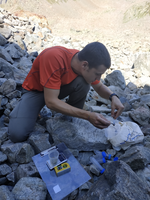Filippo Milano
- Dottorato in Scienze Biologiche e Biotecnologie applicate
- Phd: 33rd cycle
- Dottorato in Scienze Biologiche e Biotecnologie applicate
- Matriculation number: 808422
- ORCID: orcid.org/0000-0002-7393-9460

Phd thesis
Ecology and Conservation of Italian spiders in a climate change scenario
Despite their ecological importance and diversity, spiders (Arachnida: Araneae) are underrepresented in conservation research in comparison to other groups. The global response of spider species to the environmental variations has been investigated in detail only in the last few decades, but currently is proving to be a stimulating field of research. My PhD project aims at assessing the status of the conservation of different species of spiders occurring in Italy, focusing on their response to climate change. The status of spider conservation was firstly reviewed at the continental scale, and then the focus was extended on several species mainly threatened by global warming. The review revealed that existing international legislation considering spiders has limited coverage, as well as national and subnational conservation tools. Northern and Central European countries have the highest percentage of species assessed at the regional level, whereas in the Mediterranean basin, despite the highest spider diversity in Europe, conservation efforts are lacking both in terms of assessments and national or subnational legislation. Stemming from this general framework, my PhD project provided detailed insights into the conservation status of several emblematic spider species dwelling in habitats that are mostly affected by the impacts of climate change, namely Argyroneta aquatica and Dolomedes plantarius (wetlands), Vesubia jugorum (high-mountain habitats), species of the genus Troglohyphantes and Histopona palaeolithica (caves). Present, past and future distribution ranges were investigated using species distribution models for different integrated emission scenarios. These, were combined with knowledge on species’ dispersal limitation to account for the possibility that the species will not be able to move beyond the current range in the next decades. In one case, models were integrated with phylogeographic analyses to investigate the effects of past and future climate change on species distribution and genetic diversity. For all species, the extinction risk was assessed according to the global and regional guidelines of the International Union for Conservation of Nature (IUCN), and for one species the relationship between habitat suitability and functional traits related to species performance was explored. Overall, a common significant future shift in the geographic range towards higher latitudes and altitudes was found, resulting in a global future reduction in habitat suitability. Ongoing climate change is predicted to cause relevant future impacts on these species and significant decline in their current distribution range and habitat quality. The application of the IUCN criteria qualifies most of them as threatened, raising concerns for the long-term persistence of these species and suggesting potential high risk of local extinction for the most restricted ones. Considering the current threats to the spider species investigated, the protection of large areas of suitable habitat should be considered as the most effective approach to their conservation. Understanding the conservation status and the level of extinction risk faced by poorly known species is one of the greatest challenges facing conservation biology. In the framework of a general lack of knowledge on the conservation status of spiders, the collection of these works aims at providing a significant contribution to the knowledge of the Italian spiders, from the ecological and especially conservation point of view.
Research activities
My PhD program is focused on the conservation of Italian spiders, mainly in relation to the response of the most relevant spider species to the current threats to biodiversity, primarily climate change.




